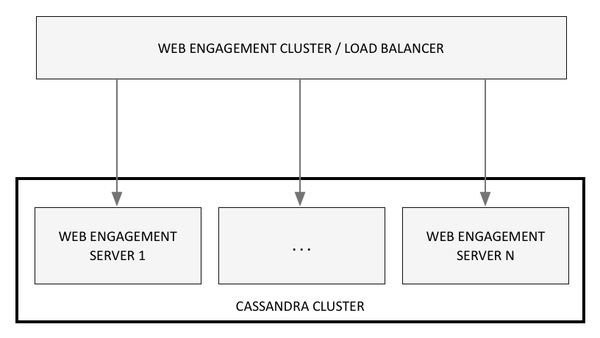Deployment Scenarios
Genesys Web Engagement has two flavors of deployment: the simplest is appropriate for a lab environment, while a production environment requires solution that is a bit more complex. Select the appropriate tab below for details about each deployment scenario and the tasks to install and configure GWE.
Overview
This deployment is appropriate for a lab environment and consists of a single Web Engagement Cluster and a single Web Engagement Server node—they can be installed together on the same host.
Deployment Tasks
Complete the following tasks to deploy Genesys Web Engagement:
- Review the prerequisites. Make sure your planned environment meets the requirements for Genesys Web Engagement and contains the right versions of the required Genesys components.
- Install the Web Engagement servers. Complete these procedures to configure and install the cluster and node.
- Configure Genesys Rules System. You need to configure Genesys Rules Authoring Tool and Genesys Rules Development Tool to work with GWE.
- Install the Plug-in for Workspace Desktop Edition. You will need this plug-in to enable chat and web callback engagement features in Workspace Desktop Edition.
- Install the Plug-in for Genesys Administrator Extension. You will need this plug-in to create categories for your application and to generate the instrumentation script snippet that needs to be placed on your website.
- Configure your required security. You can enable SSL, configure TLS for Genesys and GWE servers, and enable authentication for the Web Engagement Server, Workspace Desktop Edition, and the Engagement Strategy.
- Configure your required features. You can set up the pacing algorithm, enable authentication and SSL, and more.
- Develop an application. You're now ready to move on to the Developer's Guide, where you will learn how to develop and customize a Web Engagement application, not to mention being able to create categories, business events, and rules.
Overview
This deployment scenario is appropriate for a production environment and consists of a single Web Engagement Cluster and multiple Web Engagement Server nodes. Ideally, these servers should be installed on separate hosts to provide the best performance and the best high availability.
The figure below shows the minimum solution size Genesys recommends for a production deployment.
Deployment Tasks
Once you have thoroughly explored Web Engagement's features in your lab environment, you can complete the following tasks to deploy Genesys Web Engagement in production:
- Review the prerequisites. Make sure your planned environment meets the requirements for Genesys Web Engagement and contains the right versions of the required Genesys components.
- Install the Web Engagement servers. Complete these procedures to configure and install the cluster and nodes.
- Configure Load Balancing. This guide includes sample configurations for Apache and Nginx, although your settings may be different depending on the architecture of your cluster.
- Configure External Cassandra. Genesys recommends that you use an external Cassandra ring in your production environment. This article discusses how to do that.
- Enable SSL. You need to use a certificate issued by a third-party Certificate Authority for a production environment.
- Configure your other required security. You can also configure TLS for Genesys and GWE servers, and enable authentication for the Web Engagement Server, Workspace Desktop Edition, and the Engagement Strategy.
- Configure Genesys Rules System. You need to configure Genesys Rules Authoring Tool and Genesys Rules Development Tool to work with GWE.
- Configure your required features. You can set up the pacing algorithm, enable authentication and SSL, and more.
- Install the Plug-in for Workspace Desktop Edition. You will need this plug-in to enable chat and web callback engagement features in Workspace Desktop Edition.
- Install the Plug-in for Genesys Administrator Extension. You will need this plug-in to create categories for your application and enable GWE on your website.
- Develop an application. You're now ready to develop and customize your production Web Engagement application.


